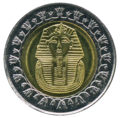Bi-metallic coin

Bi-metallic coins are
History
This section may require cleanup to meet Wikipedia's quality standards. The specific problem is: modern circulating coins list needs tidying up. (December 2020) |
Bi-metallic coins and medals have been issued for a long time. The
In the 1830s and 1840s, British medalist Joseph Moore produced large numbers of bi-metallic "penny model" and less common "halfpenny model" tokens, as a proposal to replace the relatively large penny and halfpenny coins.[4][5] Though not legal tender, Moore's tokens were circulated widely and accepted at face value by many merchants. Despite their popularity, the Royal Mint rejected the proposal, and did not reduce the size of the penny and halfpenny until decimalization.[6]
The first modern circulating bi-metallic coin was the Italian 500 lire, first issued in 1982.[7] Based on the minting process of the lire coin, the following issued bi-metallic coins for circulation were issued:[citation needed]
- Morocco, with its 5-dirhams coin in 1987;
- France, with a 10-francs coin in 1988;
- francs;
- Thailand, with a 10 baht, in 1988;
- Czech Republic, with a 50 Kč coin in 1993;
- Hong Kong, with a $10 coin, in 1993;
- Indonesia, with a Rp1,000 coin, in 1993;
- Israel, with a ₪10 coin in 1995;
- Canada, with a $2 coin (nicknamed "toonie") in 1996;
- Hungary, with a 100-forint coin in 1996 and a 200 forint coin in 2009;
- Brazil with the 1 real coin, in 1998;
- The £2coin since 1997, and a bi-metallic £1 coin since March 2017;
- The Philippines has minted a bi-metallic 10-peso coin from 2000 to 2017 and a 20-peso coin since 2019.
- The Eurozone circulated the €1 and €2 coins on 1 January 2002;[8]
- India has issued a bi-metallic ₹10 coin since 2009 and a bi-metallic ₹20 coin since 2019;
- Singapore has issued a bi-metallic 1-dollar coin since 2013.[9][10]
- Japan has issued a bi-metallic 500 yen coin since 2021.
- Costa Rica announced a bi-metallic 500-colones coin that will start to circulate in November 2021.[11]
The first ever tri-metallic circulating coins were 20-francs coins introduced in France and Monaco in 1992. These were similar to the corresponding bi-metallic 10-francs coins, but had two rings instead of one.
Use
As well as circulating coins, where they are generally restricted to high-denomination coins, bi-metallic coins are often used in
Manufacturing

The manufacturing process is similar to that of ordinary coins, except that two blanks (the inner and the outer) are struck at the same time, deforming the separate blanks sufficiently to hold them together.[13]
Countries

Examples
-
Two "Kelapa Sawit" (oil palm) bi-metallic Rp1,000 coins, with the second one being minted in 1996
-
2008 "King Tutankhamun" bi-metallic £E1 coin.
-
₹10 bi-metallic coins from India.
-
1992 French20 francstri-metallic coin.
References
- ^ "bimetallic | Definition of bimetallic in English by Oxford Dictionaries". Oxford Dictionaries | English. Archived from the original on September 26, 2016. Retrieved 2019-04-08.
- ^ a b "History of Bimetallic Coins". www.fleur-de-coin.com. Retrieved 2019-04-09.
- ^ "Bi Metal Coins From ancient Rome Till present Day". Coins Auctioned. Retrieved 2019-04-09.
- ^ "Joseph Moore, Medal Designer (1817-?)". Museums Victoria Collections. Retrieved 2019-05-27.
- ^ "BBC - A History of the World - Object : Victorian One Penny Model Coin". www.bbc.co.uk. Retrieved 2019-05-27.
- ^ "Message - UK Finds Database -". www.ukdfd.co.uk. Retrieved 2019-04-15.
- ^ Standard catalog of world coins. 1993-12-01.
- ^ "ECB: Introduction". ECB. ECB. 12 November 2020.
- ^ "A Brief History: Looking into the World of Bi-Metal Two Pound Coins | British Pobjoy Mint". www.pobjoy.com. Retrieved 2019-04-11.
- ^ "Circulation Currency > Coins". www.mas.gov.sg. Archived from the original on 2019-04-11. Retrieved 2019-04-11.
- ^ "Banco Central presenta nueva moneda de ¢500 para conmemorar el Bicentenario de Costa Rica".
- ^ "Bimetallism". eh.net. Retrieved 2019-04-17.
- .
External links
 Media related to Bi-metallic coins at Wikimedia Commons
Media related to Bi-metallic coins at Wikimedia Commons





